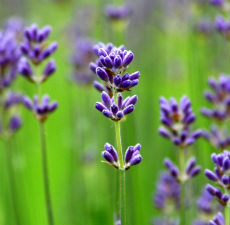Lavender Essential Oil
Botanical Name: Lavandula angustifolia
Common Method Of Extraction: Steam distilled
Parts Used: Flowering tops
Note Classification: Middle
Aroma: Sweet, floral, herbaceous
Largest Producing Countries: Bulgaria, France, and Ukraine
Traditional Use: Lavender oil is known for its skin healing properties and its use as a sedative. The herb has been used for strewing, and the flowers are used as an aromatic.
Properties: Analgesic, anti bacterial, anti depressant, anti-inflammatory, anti microbial, anti rheumatic, antiseptic, anti spasmodic, aromatic, carminative, cholagogue, deodorant, diuretic, emmenagogue, hypotensive, insecticide, nervine, sedative, stimulant, stomachic, vulnerary.
Benefits: Acne, allergies, amenorrhea, asthma, athlete's foot, bruises, burns, colic, conjunctivitis, cystitis, dandruff, depression, dermatitis, earache, eczema, flatulence, halitosis, headache, hypertension, indigestion, infection, inflammations, insect bites and stings, insomnia, laryngitis, leucorrhea, migraine, nausea, nervous tension, neuralgia, psoriasis, rashes, rheumatism, scars, slow digestion, sore muscles, sprains, stress, sunburn, teething, toothache, ulcers, wound. Lavender oil is a good addition to most skin care products. For bug bites and burns the oil is generally safe to apply neat to the affected area. A skin patch test should be performed before using any essential oil directly on the skin.
Of Interest: The name “lavender” is derived from the Latin lavare, meaning, “to wash”. Known as one of the seven polyvalents (effective against many toxins), which are applicable to many ailments. Greeks and Romans perfumed their bathwater with lavender, burned lavender incense to appease their wrathful gods, and believed the scent of lavender to be soothing to untamed lions and tigers.
Botanical Name: Lavandula angustifolia
Common Method Of Extraction: Steam distilled
Parts Used: Flowering tops
Note Classification: Middle
Aroma: Sweet, floral, herbaceous
Largest Producing Countries: Bulgaria, France, and Ukraine
Traditional Use: Lavender oil is known for its skin healing properties and its use as a sedative. The herb has been used for strewing, and the flowers are used as an aromatic.
Properties: Analgesic, anti bacterial, anti depressant, anti-inflammatory, anti microbial, anti rheumatic, antiseptic, anti spasmodic, aromatic, carminative, cholagogue, deodorant, diuretic, emmenagogue, hypotensive, insecticide, nervine, sedative, stimulant, stomachic, vulnerary.
Benefits: Acne, allergies, amenorrhea, asthma, athlete's foot, bruises, burns, colic, conjunctivitis, cystitis, dandruff, depression, dermatitis, earache, eczema, flatulence, halitosis, headache, hypertension, indigestion, infection, inflammations, insect bites and stings, insomnia, laryngitis, leucorrhea, migraine, nausea, nervous tension, neuralgia, psoriasis, rashes, rheumatism, scars, slow digestion, sore muscles, sprains, stress, sunburn, teething, toothache, ulcers, wound. Lavender oil is a good addition to most skin care products. For bug bites and burns the oil is generally safe to apply neat to the affected area. A skin patch test should be performed before using any essential oil directly on the skin.
Of Interest: The name “lavender” is derived from the Latin lavare, meaning, “to wash”. Known as one of the seven polyvalents (effective against many toxins), which are applicable to many ailments. Greeks and Romans perfumed their bathwater with lavender, burned lavender incense to appease their wrathful gods, and believed the scent of lavender to be soothing to untamed lions and tigers.
